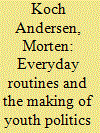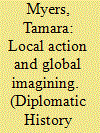|
|
|
Sort Order |
|
|
|
Items / Page
|
|
|
|
|
|
|
| Srl | Item |
| 1 |
ID:
147819


|
|
|
|
|
| Summary/Abstract |
Ideological affiliations like Africanism, charterism, and Black Consciousness shaped the political boundaries of student and youth political groups in South Africa during the tumultuous 1980s, and continue to inform contemporary youth politics. These delineations have also been used in the secondary literature to understand organizational competition and when considering how young activists negotiated contested political ground. However, this article suggests that the boundaries between opposing organizations were often blurred by their overlapping use of competing ideologies. It further argues that these divisions, although articulated ideologically, were rooted in organizational affiliation and competition for political influence and territory. It analyses the ideological development of the Congress of South African Students, the Azanian Students’ Organization, and the South African Youth Congress, and tracks the changing scope for ideological expression within charterist student and youth formations. It suggests that during the 1980s the scope for differing ideological expression narrowed, and links this process to the ANC's efforts to establish hegemony within the charterist movement. The article argues that this history is important in order to understand the ideological ‘unruliness’ or flexibility of the ANC Youth League after apartheid and the rise of Julius Malema's Economic Freedom Fighters, and considers how ideological difference within youth politics is beginning to be expressed outside the fold of charterism.
|
|
|
|
|
|
|
|
|
|
|
|
|
|
|
|
| 2 |
ID:
168567


|
|
|
|
|
| Summary/Abstract |
This article illustrates some of the practices that turn young student men into political activists. It shows how everyday routine practices bring order and meaning to a social field of hierarchical competition and conflict amongst young men at Dhaka University. The focus is on those practices that make and shape the organisations everyday, involving and bringing people together in a collective of activism and exclude others. Routines continuously reconstruct relations of hierarchy, organisational order and operation, which on one hand, transform individuals from students into activists, on the other hand, it produces structured hierarchies and operational logics. It makes activism and shapes organisations. The article concludes that a focus on the internal dynamics of mobilising organisations, mundane intimate interactions and the display of public practices, can pay dividends when it comes to a deeper understanding of the formation of political activism.
|
|
|
|
|
|
|
|
|
|
|
|
|
|
|
|
| 3 |
ID:
132018


|
|
|
|
|
| Publication |
2014.
|
| Summary/Abstract |
In the late sixties Canadian young people drew attention to global humanitarian crises through the relatively recent innovation of the hunger march. At its peak of popularity, the Miles for Millions walkathon functioned not only as a fundraising tool but as a consciousness-raising vehicle around issues of global significance, including famine, poverty, and war. Children and youth played both symbolic and material roles in the emergence of international development politics and praxis and were fundamental to making the walkathons a spectacular fundraising success. The Walk helped hundreds of thousands of young people imagine themselves belonging to a transnational community in which children mattered. At the same time, imagining global connections between children and youth became intrinsic to Canadian students' sense of nation that insisted on the importance of the country's response to international need. Empathic, emphatic, idealistic, and at times naïve, Canadian youth met the challenge of the Miles for Millions walkathon and were responsible for the millions of foundational dollars raised for the era's international development projects.
|
|
|
|
|
|
|
|
|
|
|
|
|
|
|
|
| 4 |
ID:
030093


|
|
|
|
|
| Publication |
London, Harrap, 1990.
|
| Description |
256p.:illHbk
|
| Standard Number |
024554884X
|
|
|
|
|
|
|
|
|
|
|
|
Copies: C:1/I:0,R:0,Q:0
Circulation
| Accession# | Call# | Current Location | Status | Policy | Location |
| 032091 | 909.82/NIC 032091 | Main | On Shelf | General | |
|
|
|
|
| 5 |
ID:
090575


|
|
|
|
|
| Publication |
2009.
|
| Summary/Abstract |
For any student of Soviet politics, Uzbekistan's Kamalot youth organisation is immediately familiar. Modelled after the Soviet Komsomol, Kamalot is designed to capture the hearts and minds of Uzbekistan's burgeoning youth population. It may be trite to conclude a country's youth is its future. Nowhere in Central Asia, though, is this more the case than in Uzbekistan. In 2015, 47% of Uzbekistan's population will have been born after the Soviet collapse.
|
|
|
|
|
|
|
|
|
|
|
|
|
|
|
|
|
|
|
|
|